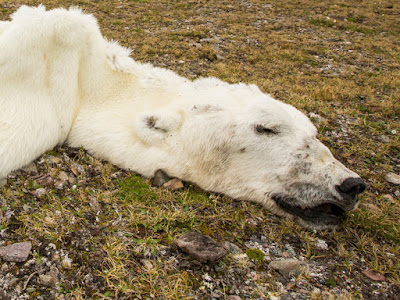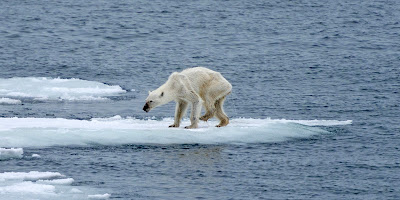A 16-year-old male polar bear was found dead on a beach north of Norway. After examining the bear’s emaciated body, researchers determined that the bear starved to death due global warming. Record high temperatures have melted arctic ice sheets that this and other polar bears need for hunting. Making matters even more tragic, this same malnourished polar bear was in good health when researchers examined it just three months prior in southern Svalbard.
Polar bear populations are believed to have declined in recent decades due in large part to global warming, though populations are difficult to track due to the bears' remote habitats.
Polar bears are highly specialised mammals which rely heavily on sea ice for food and other aspects of their life cycle. Satellite data show that Arctic sea ice has been decreasing for the past 30 years, and projections show that this trend will continue as temperatures carry on rising.
The changes in sea ice affect polar bears in several ways:
- The early retreat of summer sea ice means that bears have less time to hunt and therefore less time to build up fat reserves.
- The fragmentation and reduction in sea ice has several impacts. It forces the bears to swim longer distances, using up some of their fat reserves. It also reduces the number of seals, which are the bears’ main source of food, and impedes travelling and den making. And it also forces the bears to spend more time on land, with increased interactions with humans potentially leading to higher mortality.
The polar bears are born in dens or caves on land while their mother sleeps through the winter. The mother and the babies emerge around March famished from a long seclusion and must immediately hunt to feed themselves to stay alive.
Now, polar bears cannot hunt on land, the only hunting they know is to catch seals from floating ice in the open ocean.
The floating ice is located at the edge of the polar ice cap – a floating frozen mass that covers the North Polar arctic region, which is all ocean.
So in March the polar bear mother and cubs swim from the land in Spitsbergen to the edge of the polar ice cap so that they can hunt.
Normally this is a short swim, since in March the polar ice cap is very close to the land, and the polar bears, even babies, are good swimmers. However, last year we saw that the polar ice cap had really shrunk in size due to meltdown from global warming.
This meant that the polar bears had to swim many miles from the land in Spitsbergen – sometimes hundreds of miles – to find the floating ice where they can hunt.
Swimming hundreds of miles, specially when you are famished and have hungry babies in tow is really very hard and many bears are dying through drowning and starvation.
To get an idea of the potential impacts of future climate change on polar bears, we can look at subpopulations found at the bears’ southern range, where habitat changes have been most noticeable so far. A good example is the western Hudson Bay subpopulation, which is one of the best studied. Here, ice floe break-up is taking place earlier than 30 years ago, effectively reducing the feeding period by about three weeks. As a result, the average weight of female polar bears has dropped by about 21% between 1980 and 2004, and the population declined by 22% between 1987 and 2004. In Alaska, there is evidence of increased cub mortality caused by a decline in sea ice.
The polar bears are just one example of endangered animals because of man’s great appetite for energy which is obtained by burning fossil fuels. All life on earth could be in the balance unless we change our ways.
It's not too late. Act now to effect change.
Your actions today will help prevent potentially catastrophic changes from taking place—not only helping polar bears, but also preserving the climate that has allowed humans to flourish.










